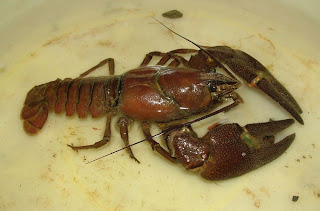Crayfish plague is a serious disease of freshwater crayfish in Europe. It is endemic in North America but rarely causes overt disease in North American species except when they are stressed. Early reports of crayfish deaths suggest that crayfish plague was present in Europe by 1875 and, although the source of infection was never proved, it was suspected to have been introduced with live, imported North American crayfish. There were further introductions of North American crayfish to Europe, most notably in the 1970s.
The earliest report in 1875 is from Italy, but the disease appears to have spread to the rest of Europe after 1975 from outbreaks in France and Germany. It has now been reported in Norway, Finland, Sweden, Russia, Germany, France, Switzerland, Spain, Greece, Turkey, the United Kingdom and Ireland. Losses of native European freshwater crayfish species have been catastrophic in infected waterways, and considerable resources have been allocated in several countries (including Finland and the United Kingdom) in an attempt to eradicate or control the disease.
The advent of molecular techniques has confirmed earlier suspicions that A. astaci entered Europe from North America. Four major strains of A. astaci have been found. Three have been identified on the signal crayfish, Pacifastacus leniusculus, which is one of the main North American species introduced to Europe. One strain appeared to have been introduced to Europe in the nineteenth century, a second was introduced to Sweden from the United States after 1970, and a third was found on Pacifastacus leniusculus from Canada. A fourth strain, found on Procambarus clarkii (red swamp crayfish) in Spain and the United States, is adapted to warmer water temperatures. The origin of outbreaks in Europe can now be traced using molecular tools.
Crayfish plague has never been reported in Australia or found during passive surveillance. To date, no outbreaks of crayfish plague have been reported in red claw in Europe, Ecuador or the United States despite the export of this species. Likewise, although Pacifastacus leniusculus has been introduced to Japan, and Procambarus clarkii to Kenya, South America, China, Japan, Taiwan and the Philippines, there have been no reports of crayfish plague in those countries.
Crayfish plague must be suspected whenever there is a mortality event in which many crayfish die but other aquatic animals remain unaffected. Diagnosis is based on clinical signs, histopathology and laboratory culture of the disease agent. Methodology for diagnosis and isolation techniques is based on culture and characterisation of the fungus, and can be found in:
• The OIE Manual of Diagnostic Tests for Aquatic Animals (OIE 2003);
• The OIE International Aquatic Animal Health Code (OIE 2004);
• Crayfish plague (Aphanomyces astaci) Australian and New Zealand Standard Diagnostic Procedure (ANZSDP)2; and
• Molecular diagnostic tests to detect epizootic ulcerative syndrome (Aphanomyces invadans) and crayfish plague (Aphanomyces astaci).



 7:52 AM
7:52 AM



 Posted in:
Posted in: 





0 comments:
Post a Comment